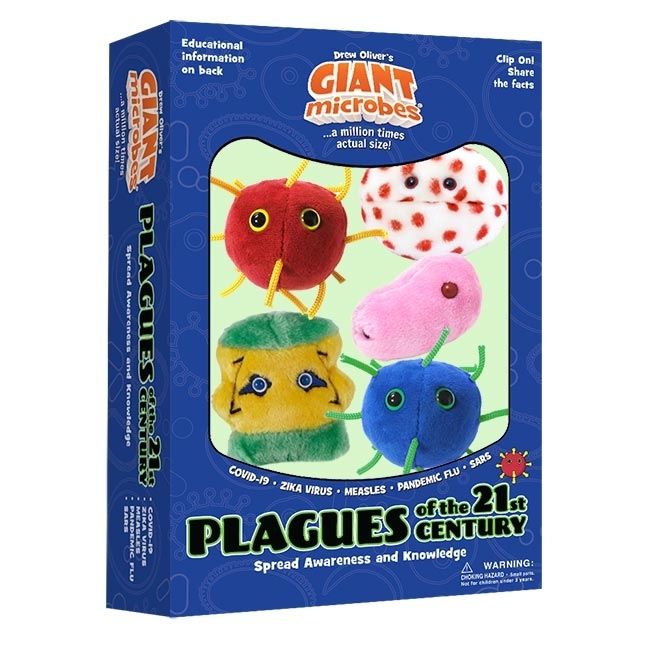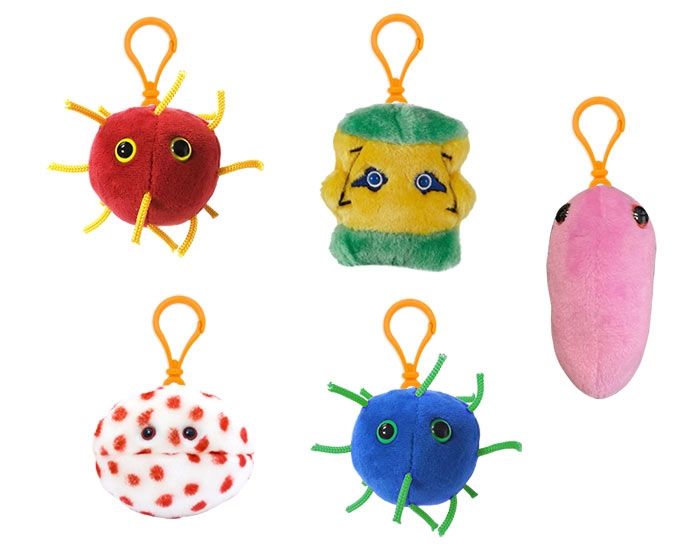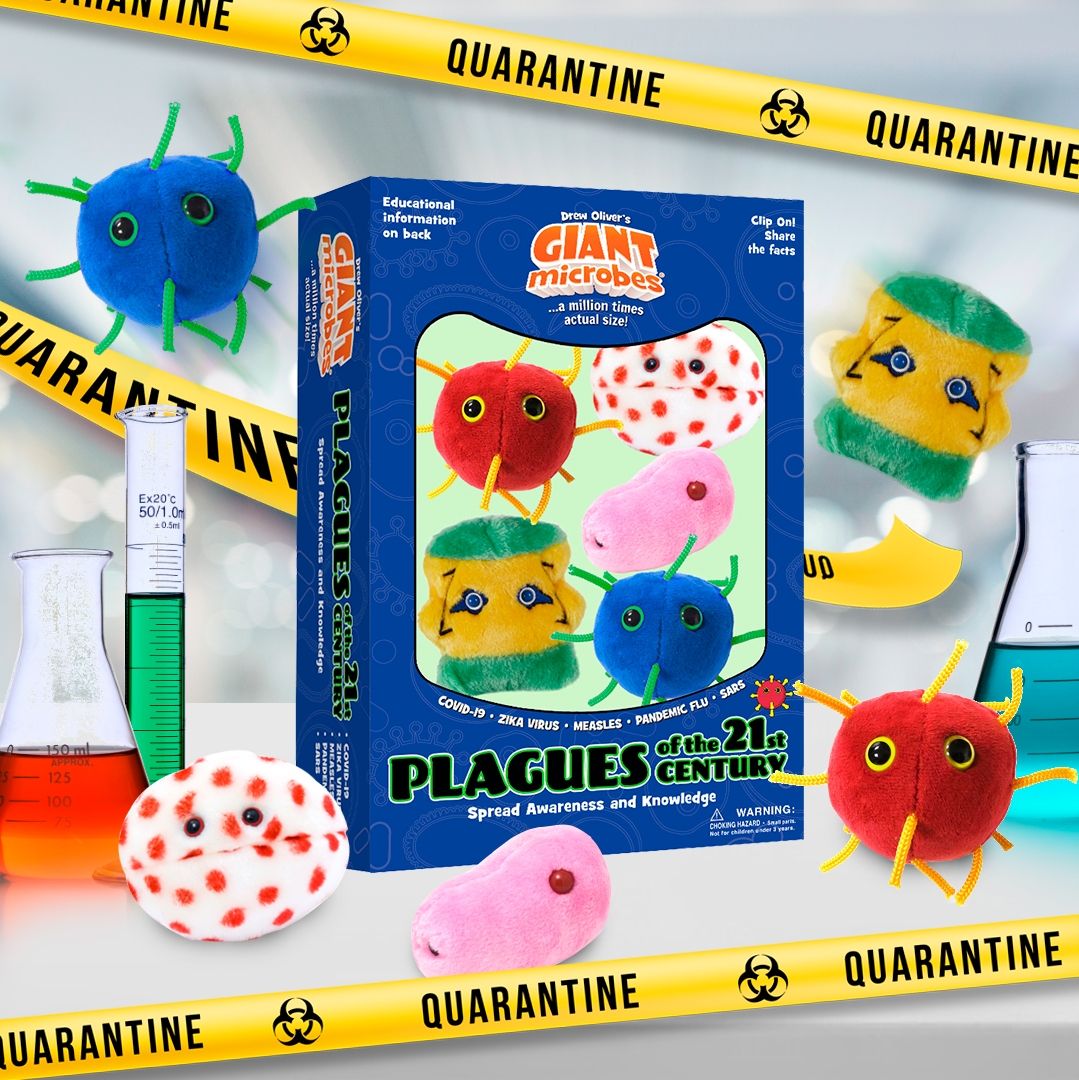Plagues of the 21st Century
This pack of nasty microbes that have wreaked havoc in recent times will help you spread the facts and give you some perspective. Spread awareness and knowledge of these deadly, modern plagues.
Plagues of the 21st Century themed gift box includes these mini microbes: COVID-19, Zika Virus, Measles, Pandemic Flu and SARS.
Clip them onto your backpack, keys or anywhere! Includes key chain clips.
Click here to view an animated cartoon about plagues and how they spread.
Product Details
Additional Information
| Sizes | Giantmicrobes are based on actual microbes, cells, organisms and other critters, only 1,000,000 times actual size! Gigantic (GG) 40-60cm XL (XL) 25-38cm Original (PD) 12-20cm Keychain (KC) 5-10cm with clip |
|---|---|
| Materials | Plush from all new materials. Stuffed with polyester fiber fill. Surface washable: sponge with water & soap, air dry. |
| Packaging | Each plush microbe includes a printed card with fun, educational and fascinating facts about the actual microbe or cell. |
| Safety | Every product meets or exceeds U.S. and European standards for safety. For ages 3 and up. |
All about Plagues of the 21st Century
COVID-19 - Cities are locked down and economies quiver. The coronavirus disease COVID-19 arrived in 2019 and quickly spread globally along with confusion, rumors and fear. Scientists investigate vaccines as nations “go medieval” by quarantining citizens. When a mysterious microbe comes knocking and the threat of pandemic is in the air, stay calm and learn the facts.
COVID-19 is respiratory, spreading mainly in coughs and sneezes. Compared to the flu, it may be more contagious and deadly. Symptoms can include fever, cough and shortness of breath. To prevent illness avoid contact with sick people, wash your hands and do not panic.
ZIKA - The Zika virus causes devastating birth defects and neurological disorders. It is transmitted to people by the bites of infected Aedes mosquitoes, which live in the Americas, Africa and Asia. Most infected people have no symptoms, while some have a fever, rash and muscle pain.
Zika became a public health emergency in 2016 when it emerged in Brazil and spread globally. Increases in human population and travel combined with climate change have helped this disease spread. There are still no treatments or vaccines available. Zika has not vanished so do your best to avoid this mosquito. The larger lesson is that we have to prepare for the emergence of new menacing microbes.
MEASLES - Measles is a highly contagious virus that remains a dangerous health threat. Many people catch this microbe each year despite a vaccine that's spot-on. Although its telltale symptoms are red spots and a mild fever, it is in fact a respiratory disease that can lead to fatal pneumonia and brain damage.
The good news is that most children are inoculated against measles, typically along with mumps, rubella and chickenpox when they receive their MMRV shot. The bad news is that cases have recently skyrocketed. Measles is one of the leading causes of vaccine-preventable childhood deaths, yet weak healthcare in developing countries and misinformed vaccine resistance have led to its resurgence. Vaccinations can stop this modern day plague.
PANDEMIC FLU - The flu, or influenza, is capable of killing rapidly and efficiently, more so than any other known virus. The seasonal flu sickens millions annually. But new flus can lead to global pandemics. All flus originate in wild ducks, gulls and other water birds. When certain strains spill over to infect mammals, deadly hybrid flus can emerge.
Swine flu, the H1N1 strain, is a mix of pig, bird and human flu viruses. H1N1 caused the last four flu pandemics including the 1918 Spanish Flu, nightmarishly fatal to over 50 million people who had no immunities against that unfamiliar strain. The flu is full of surprises, so we best pay attention and prepare.
SARS - Years before COVID-19 arose to plague our world, the first coronavirus to inflict serious illness upon people was SARS, severe acute respiratory syndrome. In 2003, SARS jumped from its animal host to humans. From China it spread to 32 countries, infecting over 8,000 people with respiratory disease and killing 774.
The SARS epidemic was deadly but it did not rise to the level of a pandemic. Scientists were quick to identify this novel virus and health experts were efficient in isolating cases. Humanity was also lucky. That coronavirus vanished and was nearly forgotten, that is until its cousin COVID-19 emerged in a much bigger way.











